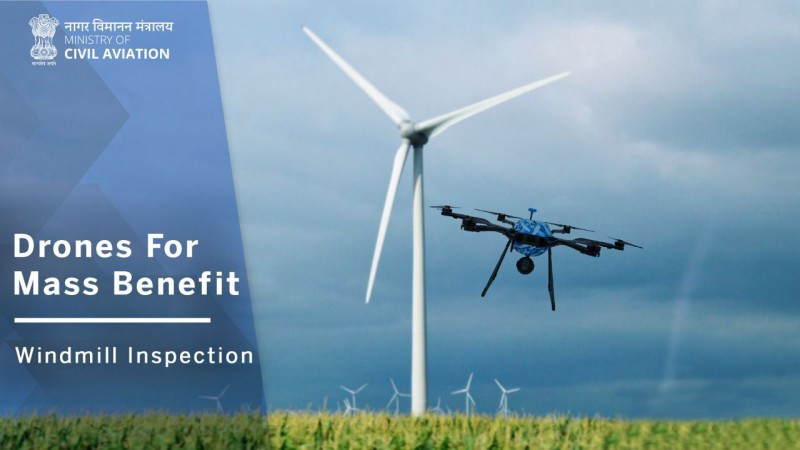Nearly 70% of India's airspace is open to compliant drones

Amber Dubey, the joint secretary of the Ministry of Civil Aviation of India and the head of the UAV Department, said that as of August 15, nearly 70% of India’s airspace has been allowed to allow compliant UAVs to enter. UAVs that comply with the "not allowed, do not take off" (NPNT) agreement will be able to fly in the airspace divided by green (free airspace) and yellow (controlled airspace).
By July this year, the Ministry of Environmental Protection had cleared all green areas across the country. This development is expected to promote local drone manufacturing.
As of August 15, 2020, the yellow areas of all drones that meet the npnt standard in India have been activated on the single-window digital sky platform. Green areas across the country will be opened in early July 2020. Therefore, nearly 70% of India's land is open to drones that meet the npnt standard.
The remaining 30% of the area belongs to the restricted red area (urban areas, strategic assets, border areas, airport funnel areas, etc.), where drones can fly but require special permission from security agencies.
Great work from the team of DGCA, AAI, IAF, MHA, MoD, security agencies, MoCA and Bangalore system integrator HMTL.
Interestingly, in May 2020, in view of the interference related to the new crown virus, someone proposed to the high-level authorities to postpone the deadline of August 15, 2020 by two months. This statement was politely but firmly denied. It is great to see all ministries, agencies, industries, and academia working together to achieve this goal.
The next version is expected to be released on October 2, 2020, when more features will be activated on the single-window DigitalSky platform.
Dolby wrote in a LinkedIn post. As the platform prepares for the first phase of launch on October 2, drones that meet the NPNT standard will be able to seek automatic permission from the digital sky portal to fly over permitted airspace, which is nearly two years away from the original vision Up. Once online, the platform will be integrated with other government entities, allowing management of airspace workflows, planning of drone flights, and recording of post-flight data submissions. The task of IT service company happy Minds is to develop a digital sky platform.
At present, it is not clear how many yellow and green areas there are in Indian airspace and the location of these airspaces. Dubei said that the red zone, which accounts for the remaining 30% of the airspace, is considered to be restricted due to its sensitivity. UAVs can fly but require special permission from security agencies.
According to the data maintained by the digital sky platform, a total of 31 drones have obtained a unique identification number (UIN), which is similar to the license plate of a drone that meets the NPNT standard. In contrast, more than 20,000 drones were awarded a drone confirmation number, which was given to older drones that did not comply with the NPNT agreement. Once the "Digital Sky" platform is fully launched, it remains to be seen whether traditional drones (most of which are manufactured by China's DJI company) will still be allowed to fly.
Hybrid Crop Spraying Drone for Indian

Hybrid Crop Spraying Drone features a gasoline + electric power system with great flight times and easy maintenance! This hybrid drone for crop spraying is portable thanks to folding arms and the modular design. The FD-416 crop dusting UAV can be used for any spraying missions – use it for agricultural, solar panel cleaning, roof spraying and anything else where a spraying drone would save you time and money! The FD-416 crop sprayer Hybrid is perfect for customers who don’t want to deal with battery charging or storage. This spraying UAV is also a great candidate for extreme cold or hot climates where drone batteries suffer.
Using drones for agriculture increases the precision and efficiency with which farmers can work, and makes it easier to make informed land management decisions. Drones can be deployed for a wide variety of tasks, including monitoring of livestock and the health of crops, estimation of soil conditions, planting of future crops, and countering infections and pests.
This powerful propulsion system allows the UAV to carry up to 16 litres of liquid in total (including the fertilizer), with a maximum takeoff weight of 40 kg. The drone can therefore operate for longer and cover more farmland in a single flight, without the need for farmers to take heavy batteries out into the field.
Product description
Model:FD-416
Number of axes:4 axis
Wheelbase: 1500mm
Power : 6000w Hybrid power
Medicine box vol1ume:max 16L
Fuel tank capacity : max 3.5L
Hybrid model: FL6000W
Full load flight time: 45 minutes
Weight:
1. Full load takeof weight: 40KG
2. Frame weight: 4.45KG
3. Hybrid powver weight: 7.2KG
4. Flight power system assembly weight: 4 * 1.65KG
5. Medicine bax weight: 1.5KG;
6. Fuel tank weight: 0.56KG






